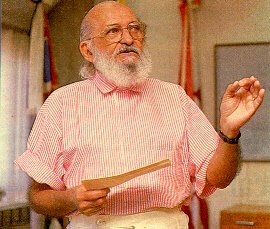I would like to start with a brief summary about Manuel Belgrano's ideas on education in general and women's education in particular. He had studied Law in Spain and there, he became familiiar with the new theories on education.
These theories had been developed by Frederick Froebel and Johann Pestalozzi, they encouraged the creation of an educational environment that involved practical work and the direct use of materials. These thinkers favoured spontaneous work and self-activity. They said that children should not be given ready-made answers but should arrive at answers themselves. The method was to proceed from the easier to the more difficult (observation-consciousness-speech-measuring-drawing-writing-numbers). The theories favoured the observation of nature in contrast with the popular belief at that moment.
Belgrano, convinced of these ideas, wanted to put them into practice in our country, but he found a great opposition among people in Government. He was in favour of free schools as a means to eradicate ignorance and misery, he wanted to create agricultural schools to teach country people how to better work the soil.
Belgrano was among the first who gave importance to women's education thinking in the role women had at home teaching children. He said that "an ignorant woman raise unable, retarded citizens". He wanted to change the educational system because, he thought, it destroyed children's imagination. He wanted education to be compulsory, with new methodology applied. He also stated that the world was full of books with important and interesting discoveries about agriculture and life in general, but those books did not reach the country people.
Belgrano had the ideas but he did not have the power or the money to make them possible. Around fifty year later, Domingo Faustino Sarmiento, who was in favour of the same ideas, and who had the power to put them into practice when he was President, took over the enterprise.
While he was President, the first population census was done and the result was that three quarters of the people was illiterate. To solve this problem he decided to create schools, libraries and to bring trained teachers from America, to teach children applying the new methodologies.
Before being President, he had been Consul in America, and there he had met Horace Mann, a well-known teacher who applied new methodologies, but it was his wife Mary the one who coordinated the import of teachers to our country. Mary recruited sixty-seven trained teachers who came here and impelled the transformation of the country into one of the countries with less illiteracy. This group of teachers were called the "Odisea laica". Lay because Sarmiento was not in favour of mixing religion with education.
Sarmiento also said that it should be taken into account the education of women, because they "destroy what teachers teach at school", meaning that women should work hand in hand with teachers, and to do so, they should be educated as well.
During Sarmiento's government, the Escuela Normal de Paranà was founded and the teachers taught there to form apt teachers for kindergarten and primary school. Mr George Sterns was in charge of the school and Mrs Sara Chamberlain Ecclestone was in charge of the teachers. In this way, "Normalism" began in our country.
The group of teachers of the Odisea Laica was formed, among others, by Sara Chamberlain Ecclestone, Frances Armstrong, who after being at Paranà, went to Còrdoba and founded the Escuela Normal and later the Escuela Normal Mixta in San Nicolàs de los Arroyos, Theodora Gay, Serena Wood, Elizabeth Gorman, Mary O. Graham, Elizabeth Peabody, Frances Hall and Jemie Howard.
Apart from this group of American teachers, Sarmiento trusted in one special woman, Juana Manso. She was a writer and a teacher who believed in the new theories. Sarmiento named her Head of the Escuela Primaria N· 1, the first mixed school in our country. She implemented the new methodology there, which was very much resisted by those who were opposed to her. She cancelled physical punishment and introduced English as a subject of study. She insisted on popular education and civil emancipation of women.
After the exposition of these data, I would like to state that, although we call Sarmiento the Father of Our Education, he carried out the ideas that somebody else, Belgrano, had thought of before. Sarmiento had the opportunity, the power and the money to do that, but this ideas were not originally his.
As regards the similarities between both men, I would state that both thought about the role of women. They said that women should be educated because they are children's first teachers and also as a way of giving them the possibility of emancipation.
In respect to the role of women in education, I would like to state that without that first step, the coming of American teachers, education based on a systematised methodology would have been impossible.
text provided by Irene Da Rold.
 While analyzing John Dewey's ideas, I was able to find a close relationship with the type of education I had at my secondary school, where the purpose was "Not Multa Sed Multum", which means "not many different things, buteach one in the deep". Moreover, a clear trend nowadays is to find teachersthat devote their classes to favouring the personal experience of the learner and their own creations.
While analyzing John Dewey's ideas, I was able to find a close relationship with the type of education I had at my secondary school, where the purpose was "Not Multa Sed Multum", which means "not many different things, buteach one in the deep". Moreover, a clear trend nowadays is to find teachersthat devote their classes to favouring the personal experience of the learner and their own creations.

